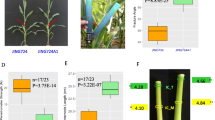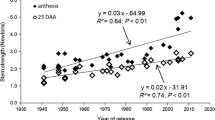Abstract
Lodging is one of the major constraints that threaten crop productivity. Although the relationship between cell walls and straw strength has been well recognized, little relevant research has been done in wheat, particularly on the monomer composition and structural characteristics of cell wall polymers and the arrangement of vascular bundles. In this study, we systematically investigated cell wall- and straw-related traits in a range of wheat germplasm resources and culm mutants using a high-throughput platform for cell wall analysis. We found that varieties with higher breaking force exhibited higher levels of crystalline cellulose but fewer hemicellulose components than other varieties. The lignin content was not consistent with the breaking force; instead, the lignin monomer constitution might be important because a significantly higher proportion of p-hydroxyphenyl (H) and guaiacyl (G) but a lower proportion of syringyl (S) monomers of lignin was found in the higher breaking force group. The crystallinity detected by X-ray diffraction was positively correlated with breaking force, indicating that the physical/chemical properties of polysaccharides also deserve attention. In terms of anatomical characteristics, the varieties with higher breaking force had a lower number and area of smaller vascular bundles in the peripheral sclerenchyma than other varieties. These results, together with the finding of a highly significant correlation between stem breaking force and straw fresh weight, 2nd internode width, flag leaf width and SiO2 content, should provide systematic information for breeding for lodging resistance.
Graphic abstract





Similar content being viewed by others
References
Acreche MM, Slafer GA (2011) Lodging yield penalties as affected by breeding in Mediterranean wheats. Field Crops Res 122:40–48
Adrees M et al (2015) Mechanisms of silicon-mediated alleviation of heavy metal toxicity in plants: a review. Ecotoxicol Environ Saf 119:186–197
Amano T, Zhu Q, Wang Y, Inoue N, Tanaka H (1993) Case studies on high yields of paddy rice in Jiangsu Province, China: I. Characteristics of grain production. Jpn J Crop Sci 62:267–274
Ambavaram MM, Krishnan A, Trijatmiko KR, Pereira A (2011) Coordinated activation of cellulose and repression of lignin biosynthesis pathways in rice. Plant Physiol 155:916–931
Berry PM, Spink J (2012) Predicting yield losses caused by lodging in wheat. Field Crops Res 137:19–26
Berry P et al (2004) Understanding and reducing lodging in cereals. Adv Agron 84:215–269
Berry P, Sylvester-Bradley R, Berry S (2007) Ideotype design for lodging-resistant wheat. Euphytica 154:165–179
Chauhan S, Darvishzadeh R, Boschetti M, Nelson A (2020) Estimation of crop angle of inclination for lodged wheat using multi-sensor SAR data. Remote Sens Environ 236:111488
Crook M, Ennos A (1994) Stem and root characteristics associated with lodging resistance in four winter wheat cultivars. J Agric Sci 123:167–174
Dong Q, Wang A, Liang S (2003) Study on the architectural characteristics of wheat stalks. J Shanxi Agric Univ 2003:188–191
Esechie H, Rodriguez V, Al-Asmi H (2004) Comparison of local and exotic maize varieties for stalk lodging components in a desert climate. Eur J Agron 21:21–30
Fan C et al (2017) AtCesA8-driven OsSUS3 expression leads to largely enhanced biomass saccharification and lodging resistance by distinctively altering lignocellulose features in rice. Biotechnol Biofuels 10:221
Foster CE, Martin TM, Pauly M (2010a) Comprehensive compositional analysis of plant cell walls (lignocellulosic biomass) part I: lignin. JoVE (J Vis Exp) 11:e1745
Foster CE, Martin TM, Pauly M (2010b) Comprehensive compositional analysis of plant cell walls (lignocellulosic biomass) part II: carbohydrates. JoVE (J Vis Exp) 37:e1837
Fukushima RS, Hatfield RD (2001) Extraction and isolation of lignin for utilization as a standard to determine lignin concentration using the acetyl bromide spectrophotometric method. J Agric Food Chem 49:3133–3139
Hai L et al (2005) Quantitative trait loci (QTL) of stem strength and related traits in a doubled-haploid population of wheat (Triticum aestivum L.). Euphytica 141:1–9
Hondroyianni E, Papakosta D, Gagianas A, Tsatsarelis K (2000) Corn stalk traits related to lodging resistance in two soils of differing salinity. Maydica 45:125–133
Huang X et al (2006) Molecular detection of QTLs for agronomic and quality traits in a doubled haploid population derived from two Canadian wheats (Triticum aestivum L.). Theor Appl Genet 113:753–766
Hyles J et al (2017) Repeat-length variation in a wheat cellulose synthase-like gene is associated with altered tiller number and stem cell wall composition. J Exp Bot 68:1519–1529
Islam MS, Peng S, Visperas RM, Ereful N, Bhuiya MSU, Julfiquar A (2007) Lodging-related morphological traits of hybrid rice in a tropical irrigated ecosystem. Field Crops Res 101:240–248
Jia H et al (2013) Genetic dissection of yield-related traits in a recombinant inbred line population created using a key breeding parent in China’s wheat breeding. Theor Appl Genet 126:2123–2139
Kamran M, Ahmad I, Wu X, Liu T, Ding R, Han Q (2018) Application of paclobutrazol: a strategy for inducing lodging resistance of wheat through mediation of plant height, stem physical strength, and lignin biosynthesis. Environ Sci Pollut Res 25:29366–29378
Kashiwagi T, Ishimaru K (2004) Identification and functional analysis of a locus for improvement of lodging resistance in rice. Plant Physiol 134:676–683
Ke S, Luan X, Liang J, Hung Y-H, Hsieh T-F, Zhang X-Q (2019) Rice OsPEX1, an extensin-like protein, affects lignin biosynthesis and plant growth. Plant Mol Biol 100:151–161
Kelbert A, Spaner D, Briggs K, King J (2004) The association of culm anatomy with lodging susceptibility in modern spring wheat genotypes. Euphytica 136:211–221
Kong E et al (2013) Anatomical and chemical characteristics associated with lodging resistance in wheat. Crop J 1:43–49
Li F et al (2013) Arabinose substitution degree in xylan positively affects lignocellulose enzymatic digestibility after various NaOH/H2SO4 pretreatments in Miscanthus. Biores Technol 130:629–637
Li M et al (2014a) Mild alkali-pretreatment effectively extracts guaiacyl-rich lignin for high lignocellulose digestibility coupled with largely diminishing yeast fermentation inhibitors in Miscanthus. Biores Technol 169:447–454
Li Z et al (2014b) The minor wall-networks between monolignols and interlinked-phenolics predominantly affect biomass enzymatic digestibility in Miscanthus. PLoS ONE 9:e105115
Li F et al (2015) High-level hemicellulosic arabinose predominately affects lignocellulose crystallinity for genetically enhancing both plant lodging resistance and biomass enzymatic digestibility in rice mutants. Plant Biotechnol J 13:514–525
Li F et al (2017) Os CESA 9 conserved-site mutation leads to largely enhanced plant lodging resistance and biomass enzymatic saccharification by reducing cellulose DP and crystallinity in rice. Plant Biotechnol J 15:1093–1104
Liu S, Huang Y, Xu H, Zhao M, Xu Q, Li F (2018) Genetic enhancement of lodging resistance in rice due to the key cell wall polymer lignin, which affects stem characteristics. Breeding Science 18050
Ma Q-H (2009) The expression of caffeic acid 3-O-methyltransferase in two wheat genotypes differing in lodging resistance. J Exp Bot 60:2763–2771
McFarlane HE, Döring A, Persson S (2014) The cell biology of cellulose synthesis. Annu Rev Plant Biol 65:69–94
Murozuka E et al (2015) Concentration of mineral elements in wheat (Triticum aestivum L.) straw: genotypic differences and consequences for enzymatic saccharification. Biomass Bioenerg 75:134–141
Naeem A, Zia-ur-Rehman M, Akhtar T, Zia MH, Aslam M (2018) Silicon nutrition lowers cadmium content of wheat cultivars by regulating transpiration rate and activity of antioxidant enzymes. Environ Pollut 242:126–135
Nguyen T-N, Son S, Jordan MC, Levin DB, Ayele BT (2016) Lignin biosynthesis in wheat (Triticum aestivum L): its response to waterlogging and association with hormonal levels. BMC Plant Biol 16:28
Ookawa T et al (2014) Increased lodging resistance in long-culm, low-lignin gh2 rice for improved feed and bioenergy production. Sci Rep 4:6567
Park S, Baker JO, Himmel ME, Parilla PA, Johnson DK (2010) Cellulose crystallinity index: measurement techniques and their impact on interpreting cellulase performance. Biotechnol Biofuels 3:10
Peng D, Chen X, Yin Y, Lu K, Yang W, Tang Y, Wang Z (2014) Lodging resistance of winter wheat (Triticum aestivum L.): lignin accumulation and its related enzymes activities due to the application of paclobutrazol or gibberellin acid. Field Crops Res 157:1–7
Rutto LK, Xu Y, Brandt M, Ren S, Kering MK (2013) Juice, ethanol, and grain yield potential of five sweet sorghum (Sorghum bicolor [L.] Moench) cultivars. J Sustain Bioenergy Syst 3:113
Sannigrahi P, Ragauskas AJ, Miller SJ (2009) Lignin structural modifications resulting from ethanol organosolv treatment of loblolly pine. Energy Fuels 24:683–689
Santoro N et al (2010) A high-throughput platform for screening milligram quantities of plant biomass for lignocellulose digestibility. Bioenergy Res 3:93–102
Segal L, Creely J, Martin A Jr, Conrad C (1959) An empirical method for estimating the degree of crystallinity of native cellulose using the X-ray diffractometer. Text Res J 29:786–794
Setter T, Laureles E, Mazaredo A (1997) Lodging reduces yield of rice by self-shading and reductions in canopy photosynthesis. Field Crops Res 49:95–106
Sun D et al (2017) Biomass saccharification is largely enhanced by altering wall polymer features and reducing silicon accumulation in rice cultivars harvested from nitrogen fertilizer supply. Biores Technol 243:957–965
Tanaka K, Murata K, Yamazaki M, Onosato K, Miyao A, Hirochika H (2003) Three distinct rice cellulose synthase catalytic subunit genes required for cellulose synthesis in the secondary wall. Plant Physiol 133:73–83
Updegraff DM (1969) Semimicro determination of cellulose inbiological materials. Anal Biochem 32:420–424
Wei L et al (2017) Genetic and transcriptomic analyses of lignin-and lodging-related traits in Brassica napus. Theor Appl Genet 130:1961–1973
Wu Z et al (2013) Biomass digestibility is predominantly affected by three factors of wall polymer features distinctive in wheat accessions and rice mutants. Biotechnol Biofuels 6:183
Wu Z et al (2014) Diverse cell wall composition and varied biomass digestibility in wheat straw for bioenergy feedstock. Biomass Bioenerg 70:347–355
Xiao S-H, Zhang X-Y, Yan C-S, Zhang W-X, Hai L, Guo H-J (2002) Determination of resistance to lodging by stem strength in wheat. Agric Sci China 1:280–284
Yadav S et al (2017) Molecular mapping of QTLs associated with lodging resistance in dry direct-seeded rice (Oryza sativa L.). Front Plant Sci 8:1431
Yao J et al (2011) Inheritance of stem strength and its correlations with culm morphological traits in wheat (Triticum aestivum L.). Can J Plant Sci 91:1065–1070
Zhang B, Zhou Y (2011) Rice brittleness mutants: a way to open the ‘Black Box’of monocot cell wall biosynthesis free access. J Integr Plant Biol 53:136–142
Zhang W et al (2013) Three lignocellulose features that distinctively affect biomass enzymatic digestibility under NaOH and H2SO4 pretreatments in Miscanthus. Biores Technol 130:30–37
Zhang J et al (2015) Silica distinctively affects cell wall features and lignocellulosic saccharification with large enhancement on biomass production in rice. Plant Sci 239:84–91
Zhang W et al (2016) Lodging resistance of japonica rice (Oryza sativa L.): morphological and anatomical traits due to top-dressing nitrogen application rates. Rice 9:31
Zhang W et al (2017) Nitrogen fertilizer application affects lodging resistance by altering secondary cell wall synthesis in japonica rice (Oryza sativa). J Plant Res 130:859–871
Zhang D et al (2018) Development and utilization of introgression lines using synthetic octaploid wheat (Aegilops tauschii × Hexaploid Wheat) as donor. Front Plant Sci 9:1113
Zhu Z, Lin R (1990) Alkaline digestion and oxidation for the speed determination of the silica in rice hull. Chin J Rice Sci 4:89–91
Zhu L, Zhong D, Xu J, Yu S, Li Z (2008) Differential expression of lodging resistance related QTLs in rice (Oryza sativa L.). Plant Sci 175:898–905
Acknowledgments
This work was supported in part by grants from the National Natural Science Foundation of China (31771775 and 31171524), the Programme of Introducing Talents of Discipline to Guangxi University (A3310051010 and EE101701), the China Postdoctoral Science Foundation (20070420917), the Natural Science Foundation of Hubei Province (2009CDB324), and the China Scholarship Council (File No. 201208420115).
Author information
Authors and Affiliations
Corresponding author
Additional information
Publisher's Note
Springer Nature remains neutral with regard to jurisdictional claims in published maps and institutional affiliations.
Electronic supplementary material
Below is the link to the electronic supplementary material.
Rights and permissions
About this article
Cite this article
Muhammad, A., Hao, H., Xue, Y. et al. Survey of wheat straw stem characteristics for enhanced resistance to lodging. Cellulose 27, 2469–2484 (2020). https://doi.org/10.1007/s10570-020-02972-7
Received:
Accepted:
Published:
Issue Date:
DOI: https://doi.org/10.1007/s10570-020-02972-7




